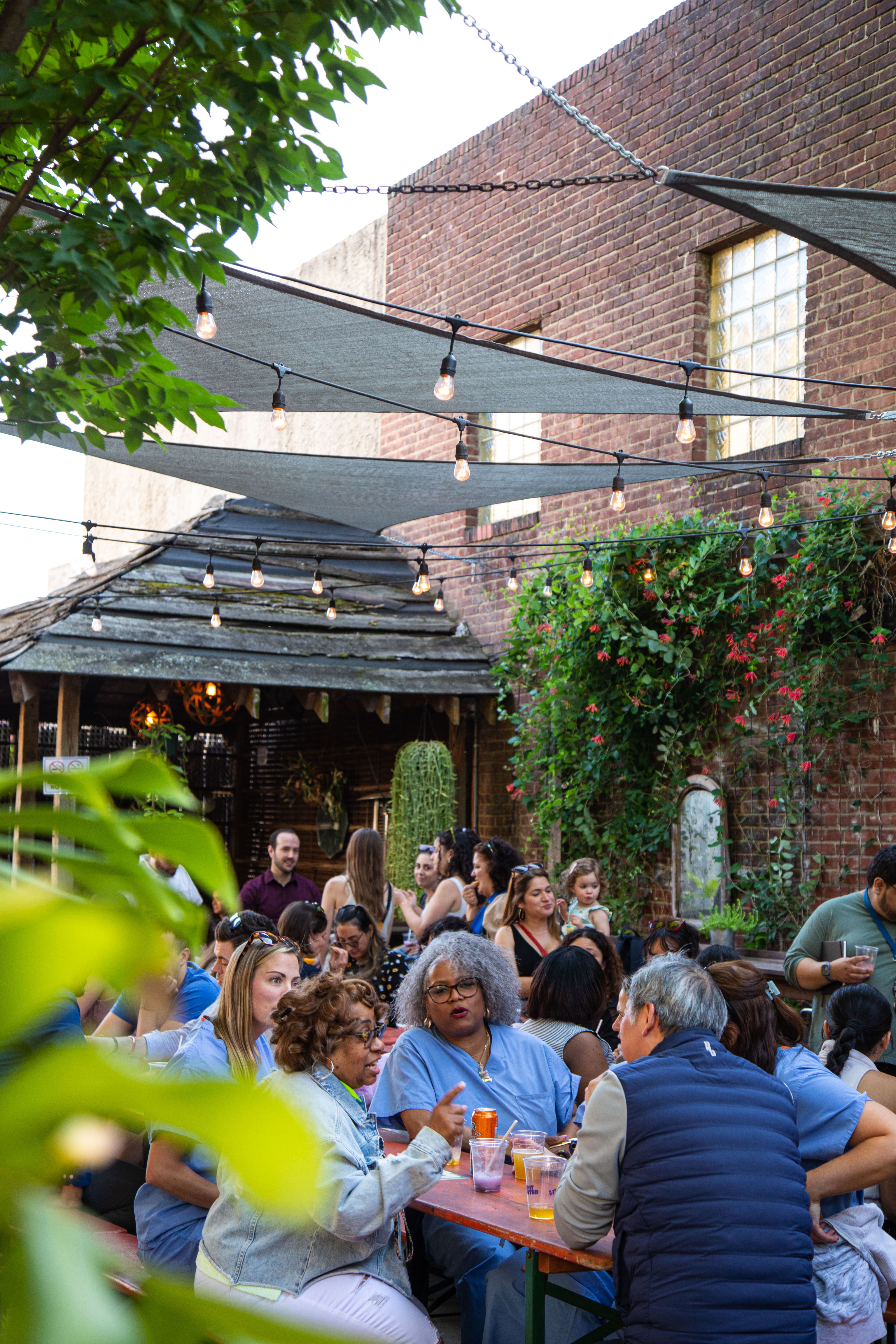
HIGHER PURPOSE
Planting trees for people and the environment

IN THIS ISSUE
Feature Story
A Living Legacy
A determined Pennsylvania resident has reforested her landscape and discovered a purpose for her golden years.

A determined Pennsylvania resident has reforested her landscape and discovered a purpose for her golden years.
by SCOTT MEYER photographs by ROB CARDILLO

When Anne Miller is asked how many trees she has planted at her Dillsburg, Pennsylvania, farm, her eyes widen and a playful grin lightens her face. “I don’t know,” she answers after a pause. “How many do you think? One thousand? Two thousand?”
About 30 years ago, the now 95-year-old started adding new trees to the York County property that she and her late husband, Tom Miller, restored and where she still lives. Today, her arboretum contains hundreds, if not thousands, of trees she has planted. She’s not done yet! While sipping mint tea that she made with fresh herbs from her garden, Anne lists the manifold species she has put in the ground, including 20 new saplings in the spring of 2023. Her efforts began as a reclamation project for the land and have evolved into an abiding passion for the wonders of trees.
Anne Miller (with Wilo, a friendly neighbor) loves the diversity of trees, such as a treasured paperbark maple. She's brought together such species as (above) weeping forms of crabapple and katsura, redbud, and a bald cypress.

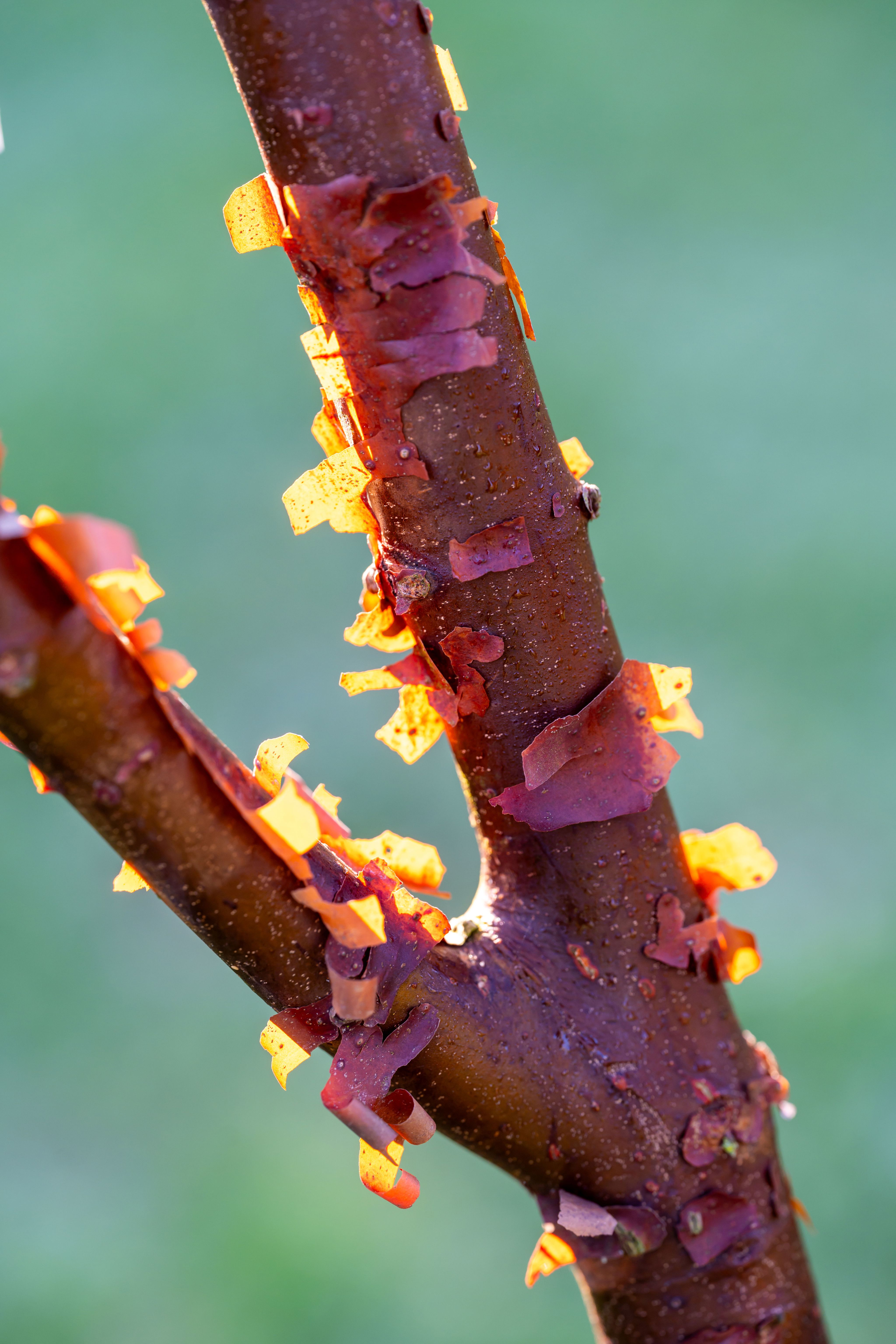


NEW DIGS
Anne Miller spent much of her childhood on her grandparents’ beautiful farm in Maryland. She, Tom, and their three young children were living in Harrisburg when they started looking for a property with more open space. “My mother told me that my children should grow up on a farm,” Anne recalls, “so we casually joined the hunt and found a home with some land.” The family lived there until their children finished school. (The couple’s oldest child, Leslie Anne Miller, has served on the PHS Board of Directors. She, her sister Sarah Miller Coulson, and their mother are regular exhibitors at the Flower Show.)
When Anne and Tom became empty nesters, a local real estate agent urged them to take a look at a farm that had recently come on the market. Although the house and barn were in disrepair and the property had been neglected, Anne saw potential, particularly in the 100-plus acres of rolling slopes and woodlands surrounding the buildings. “It was a paradise for people who loved nature and open space,” she says.
The couple purchased the property, and Anne got busy. “In the warm weather, I worked outside, and in the winter, I worked inside the house. It was a wreck, but I was determined!” She spent four years restoring the house prior to moving in. At one point, Tom suggested that they simply demolish the house and build a new one on a facing slope but she demurred. “I told him, ‘That hill is sacred; something special has to go there.’” Today, the entire property, including her “sacred hill,” is resplendent with a beautifully diverse array of trees, shrubs, and plants.
Growing trees wasn’t Anne’s initial goal. “I wanted rhododendrons, which I love and have always had wherever I lived,” she says. “I knew that rhodies need some shade, so I put in trees for them.” Anne added lots of rhododendrons and azaleas to the shady sections of the property, but before long her focus shifted to trees.
MAPLES AND MORE
The first season, Anne planted 50 Douglas firs, 50 concolor, or white, firs (a conifer with silvery blue-green, soft needles), and 50 spruce trees. Since that time, she’s added a wide range of evergreen and deciduous trees, large and small. As Anne takes a visitor on a tour of her personal arboretum, she shares the names and best attributes of a few of her favorite varieties. She highlights a tricolor beech, which has foliage that is purple with edges colored in rose and creamy pink. She marvels at the beauty as she points out the exfoliating bark of a native shagbark hickory and a paperbark maple and the cascading limbs of a weeping katsura. There are ginkgoes, hornbeams, yellowwoods, and towering bald cypresses and dawn redwoods. A few years ago, Anne planted a Persian ironwood that had been in an exhibit at the PHS Philadelphia Flower Show. It continues to grow in her landscape, still labeled with its proper sign.
Almost every specimen seems to have a story that Anne is eager to share. She tells how she acquired a treasured Japanese umbrella pine, which she admires for its elegant shape and long, soft needles. “Our family went to Bethany Beach in the summer, and some days I visited nurseries instead of the beach,” she says. “At one nursery, I saw these beautiful little umbrella tree starters in pots and asked what they were and if I could buy some. I left with a dozen or so. I took them home and waited for them to grow big enough to plant outside. They were so lovely I started giving them away to other people who liked them. I ended up with only five of them for myself.” (They are available at most nurseries today.)
Anne first fell in love with Japanese maples years ago while on a PHS trip. “I hadn’t given them much thought, but on that particular tour, I saw this incredible display of Japanese maples mass-planted on a large hillside of several acres,” she says. “It inspired me, and now I have maples on top of maples.” She has planted well over a hundred on the slope across from her front door, as well as on other parts of the property. “The leaves are different shades of red, yellow, orange, and green, and there are different types of leaves,” she says about the many types. “Their delicate beauty belies an underlying toughness.”
Toughness is a quality that Anne values—and embodies—as she walks and talks about the years of hard physical work she’s put into her home and landscape. Though she is petite, she nonchalantly describes digging holes and planting, swinging a mattock, moving boulders, and even driving tractors. She has been helped by many throughout the years, especially Richard “Hawk” Wagner. She is quick to acknowledge both his hard work and companionship.
All of her experience has left her with a philosophical point of view. “I don’t fuss over the trees. I give them a good start by planting them well and then fertilizing and watering them in the early years. (The property has no irrigation system!) After that, it’s up to nature,” she says. “They don’t all make it, which is why I keep planting.”
“I believe trees like the company of other trees. You might say it’s as if they need to be surrounded by family. They communicate with each other.”

MAKING CONNECTIONS
Anne’s journey from rhododendron admirer to tree planter to arboreal enthusiast was gradual, aided by many people that she met along the way. “At first, I didn’t really know anything about trees,” she says. “But there were so many wonderful local nurseries and talented gardeners. I just began asking questions. And I had a lot of questions.”
She remembers the day she drove with a local landscaper to visit an exceptional azalea grower in Maryland, where she’d hoped to purchase a few new varieties. She toured the fields, and as the long afternoon came to an end, the grower’s wife invited Anne and her friend in for dinner. “We did not wish to impose on people,” she says. “But they insisted we stay. I still remember the meal of roast beef and mashed potatoes. It was so delicious.” She pauses and then adds, “Typical of gardeners to share!”
She’s still in contact with local nursery people as well as her wide circle of gardening friends. Yet, over time, Anne has come to trust and rely on her own observations. “I try to follow what nature does. I’ve inherited a lot of native trees here,” she says. “I have also tried to plant trees that come from other places—especially many wonderful specimens from the Pacific Northwest—but no matter the level of care they’re given,
they don’t always survive. The natives are happier.”
As Anne’s knowledge has grown, so has her appreciation—and perhaps even reverence—for the trees that she continues to plant. “I believe trees like the company of other trees,” she explains. “You might say it’s as if they need to be surrounded by family. They communicate with each other. Many books have been written about this notion, but you don’t necessarily need a book. You can see it.” (For more on this topic, check out Finding the Mother Tree: Discovering the Wisdom of the Forest, by Canadian ecologist Suzanne Simard.)
People who reach their tenth decade of life tend to reflect on what they’ve accomplished and consider their legacies. Anne Miller is not ready for that. She offers no opinion on what she’d ultimately like to have happen to her arboretum. “I won’t be here to make that decision,” she says matter-of-factly. Instead, she’s thinking about planting more trees. “I have a few at the nursery waiting for me right now!”
As our visit ends, however, Anne does offer a strong opinion about the importance of trees to our world’s outlook. “Trees are absolutely a necessity to the ecosystem, specifically in view of climate change. But we have not been good caregivers. Eighty percent of our old-growth forests are gone. The ones that remain are humanity’s best hope for a livable future. Wake up, people! Plant trees!”

An espaliered apple tree hugs the tool shed.
Seeding the Future
It should come as no surprise that when Anne Miller’s daughters, Leslie and Sarah, were considering a meaningful way to honor their extraordinary mother, they quickly focused on her passion for trees. The PHS Tree Program provided the perfect vehicle for them to create the Anne G. Miller Tree Endowment, which reflects Anne’s commitment to planting trees while furthering the efforts of PHS to plant and care for thousands of trees in Philadelphia’s public places and city streets.
The $1 million gift will help fund two important endeavors at PHS. First, the endowment provides direct support for tree planting and stewardship in the Nicetown and Tioga neighborhoods through the implementation of the Love Where you Live program. Second, the funding will ensure ongoing support for direct and indirect costs of tree planting and related activities across PHS.
The Millers hope that this initial seed will be nourished by other gifts and will continue to grow into an even more robust endowment dedicated to the critically important work of PHS Tree Programs. What better way to perpetuate Anne Miller’s love of trees!
You can help restore the tree canopy across our region and improve the well-being of people and their communities through involvement in the PHS tree programs. Click here to join the Millers in contributing your support.
The Seasons of Meadowbrook Farm
THE ICONIC PHS PUBLIC LANDSCAPE WILL INSPIRE AND ENLIGHTEN YOU FROM SPRING TO FALL.
THE OLDEST GARDEN CARED FOR BY PHS, Meadowbrook Farm in Montgomery County, Pennsylvania, now has a refreshed look that offers visitors more spectacular views and ideas to take home than ever before. “Many of the gardens and beds around the property have been updated in the last 18 months,” says Glenn Ashton, senior gardener at Meadowbrook. “There’s so much to see in every season, including fall.”
This year, the Meadowbrook horticulture team filled the front courtyard with a mass planting of about 40 containers showcasing a variety of tropical plants that thrive into autumn. “We focused on foliage colors and textures for these containers,” Ashton says. “They’re set up on different heights of pedestals to give a tiered effect.”
The “Queen’s Garden,” one of more than a dozen garden “rooms” on the estate, has undergone a dramatic renovation. It has large troughs filled with an array of brilliantly colored dahlias that will continue until the first hard frost, Ashton says. In the back courtyard, mounted hayrack planters overflow with annuals and tropicals. Near the entrance, a new 3-foot-tall rock wall has been filled with a range of cacti and succulents, including types that are winter-hardy in this region. The Display Garden presents a multiseason show from uncommon, long-blooming plants such as Salvia uliginosa, Helianthus Suncredible, and Tricyrtis hirta ‘Alba’.
The farm is open for in-person visitors Wednesday through Saturday. Admission is free, and no reservations are needed. Click here for more details.
Click on Photos Below to Launch Gallery


Large-leaved tropicals and other colorful foliage plants shine in the Circle Garden.
Large-leaved tropicals and other colorful foliage plants shine in the Circle Garden.
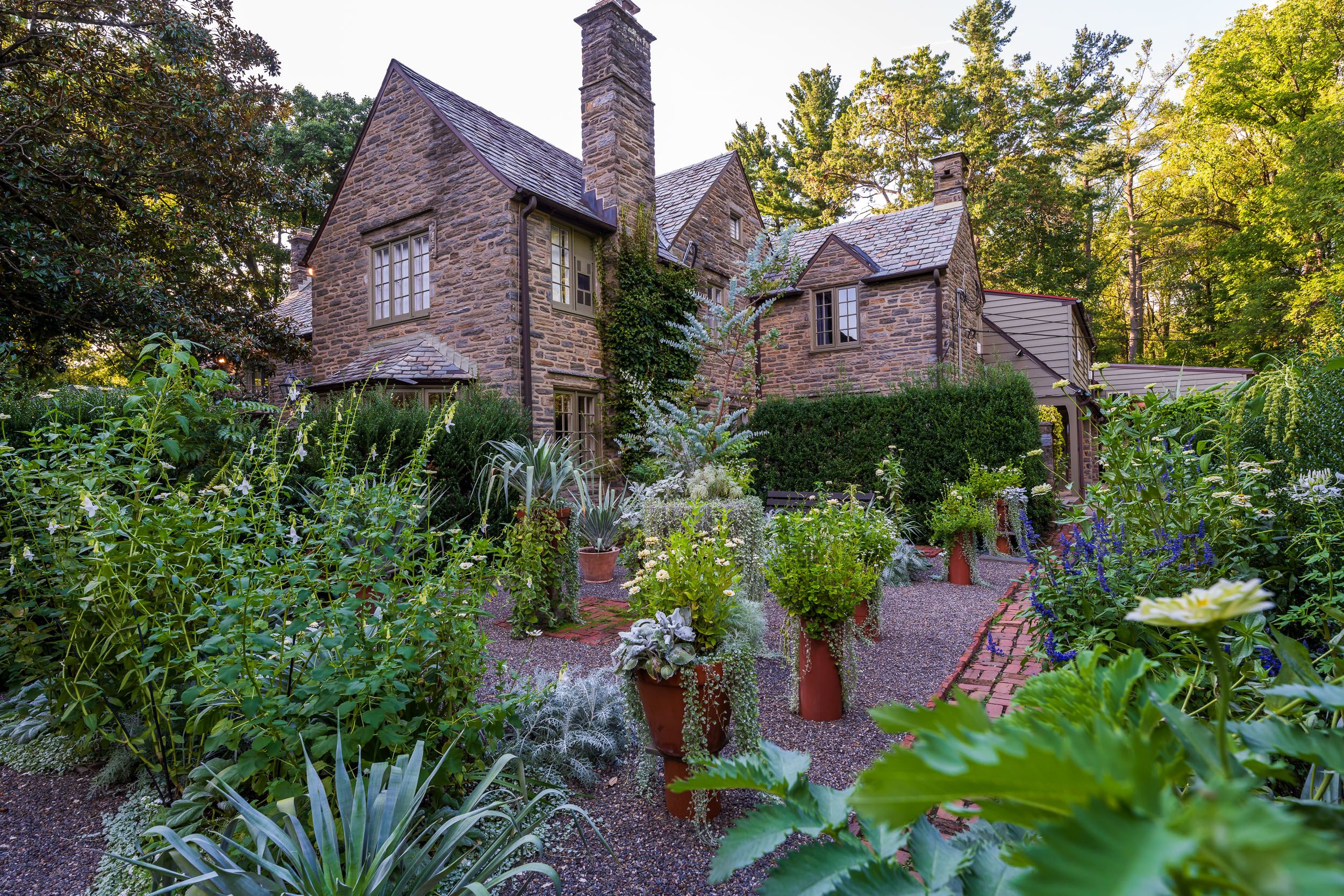
Plants with silvery foliage in elevated pots give the traditional Herb Garden a fresh look.
Plants with silvery foliage in elevated pots give the traditional Herb Garden a fresh look.

An antique sculpture, part of the original estate, comes to life with new growth each season.
An antique sculpture, part of the original estate, comes to life with new growth each season.
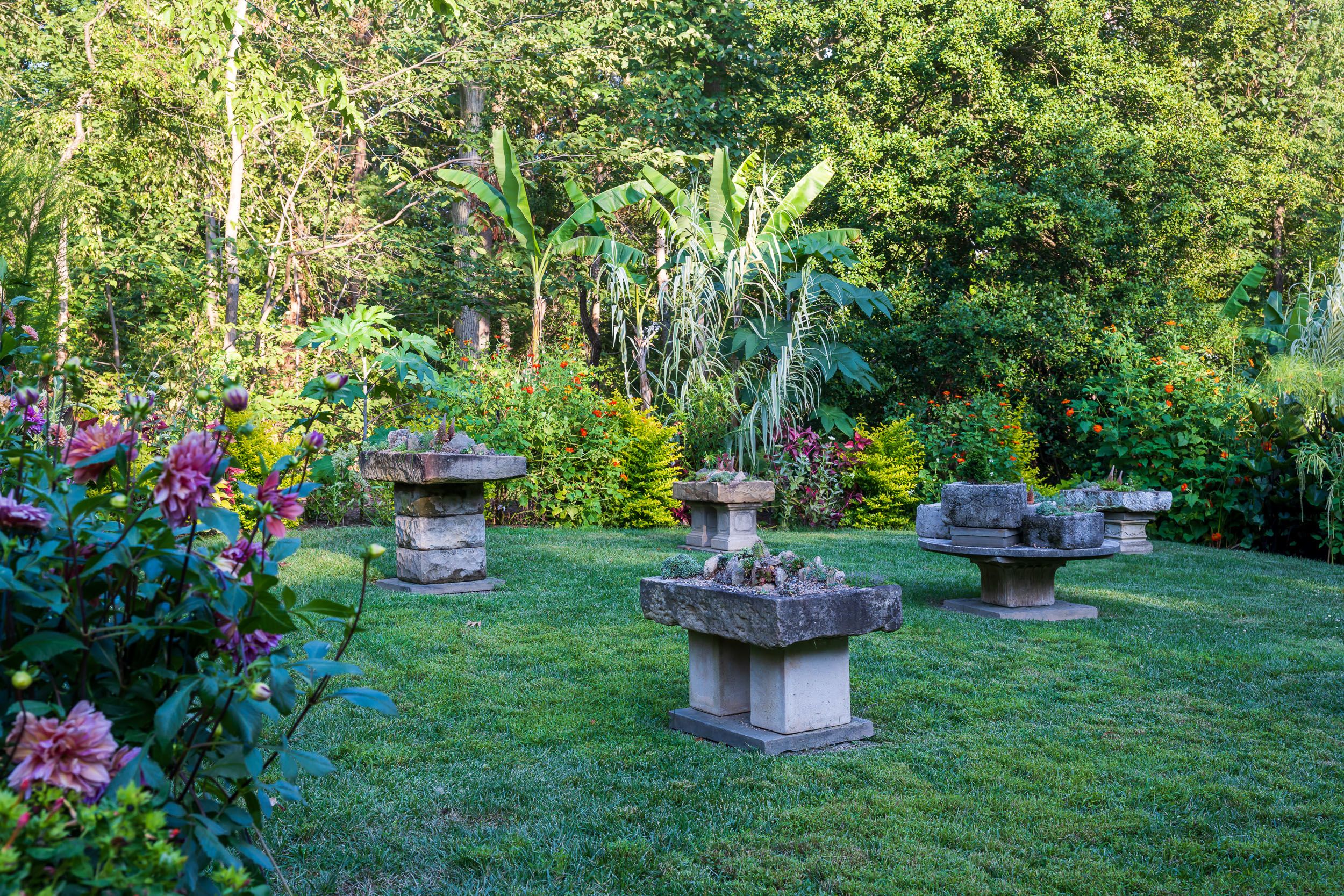
The raised rock garden troughs in the Queens Garden are like living sculpture.
The raised rock garden troughs in the Queens Garden are like living sculpture.

Succulents of all types are on display in containers and beds.
Succulents of all types are on display in containers and beds.

Hayracks overflowing with trailing plants adorn a stone wall.
Hayracks overflowing with trailing plants adorn a stone wall.

A tiered container garden greets visitors in the Front Courtyard.
A tiered container garden greets visitors in the Front Courtyard.

Growth Opportunities
A FATHER AND SON LEARN NEW SKILLS AND LAND GREEN-INDUSTRY JOBS.
by SCOTT MEYER
photographs by ROB CARDILLO
RON JACOB DESCRIBES HIMSELF and his son Rashun as “hard workers who couldn’t find work.” That circumstance has changed for the two residents of Southwest Philadelphia, thanks to the PHS Workforce Development Bootcamp. Today they’re both employed as professional landscapers and feeling hopeful about the future.
The two men are among the more than 190 people who have completed the intensive six-week course offered by PHS since 2016. The lessons focus on teaching the participants the basics of lawn and landscape maintenance, along with important job readiness skills. The effort is a partnership with the City of Philadelphia’s Division of Housing and Community Development to support people who have had direct experience with the criminal justice system or have other barriers to employment.
TRAINING DAYS
Ron Jacobs, age 41, took the first step on his journey in 2022, when Greg Thompson, a neighbor and PHS Philadelphia LandCare partner, urged him to sign up for the training. “I was looking for a job when I ran into him,” Ron says. “He told me about the program, and he said it could be good for me.”
Ron participated in the session during that spring and summer, learning about using outdoor power equipment, planting and caring for trees, shrubs, and other plants, and mulching. “I’d never done any of that before,” he says.
Like all the participants, Ron received a weekly stipend during the training period and was provided with work clothing and safety gear. “You get everything you need, the whole nine [yards],” he says. He and the other trainees worked in a variety of locations around the city, including FDR Park, where they helped to prepare the site for the 2022 PHS Philadelphia Flower Show in June.
During the second phase of the Workforce Development Bootcamp, the students are paid interns for landscaping businesses. In many cases, this is a trial period with the employer. After graduation, Ron was offered a job with All Seasons Landscaping, a PHS Philadelphia LandCare partner with many other clients around the mid-Atlantic region. Of the 39 students Ron trained with, 38 of them landed jobs, most in PHS’s network of minority-owned local businesses. Each of the graduates is also matched with a case manager to give them support as they adjust to their new roles.
“This program has done so much for me,” Ron says. “I learned skills, and now I have a good job for me and my family. I’m doing work I really love.” When enrollment for the 2023 session was forming, Ron urged Rashun to apply.
The 22-year-old son had been looking for direction and saw how his father had benefited from the experience. “He’s a hard worker, and he likes to learn things,” Rashun says. “That’s me too.” For Rashun, the training helped with “getting a steady pace, getting up early every morning, and doing the things you need to do to be at work on time every day.” Rashun was also excited to know more about plants and trees. “You have to learn about all the poison plants,” he says before describing a recent close encounter with poison ivy.
The training provides students with the knowledge needed to work at an entry-level, seasonal landscaping job. Conflict resolution, financial literacy, and other practical topics are covered as well. “You meet a lot of good people on the way,” Ron adds. “I’m still talking to some of the guys today.”
“I learned skills, and now I have a good job for me and my family. I’m doing work I really love.” —Ron Jacobs
NEW HORIZONS
When Rashun completed the course, he joined the team at All Seasons Landscaping too. The father and son sometimes work on the same crew; other times they go separate ways. They both take pride in the work they’ve done in public spaces.
“We work on a lot of big commercial projects and a lot of places around the city, like the art museums [along the Benjamin Franklin Parkway] and LOVE Park,” across the street from City Hall, Ron says. “Every time I walk by with my grandchildren, I like to show them and tell them ‘I planted that tree and those flowers.’ It’s a beautiful thing.”
“I go up and down Broad Street and tell everybody ‘I put those plants in right there,’” Rashun says with a laugh.
Both men are bringing their new skills to their own community. Ron has been asked by a neighbor to prune a couple trees. Rashun is helping his mother care for the shrubs and flowers in her yard. They’re also looking ahead.
“I want to start my own landscaping business. I want to grab tools and start doing my own thing,” Ron says. “But I’m glad right now to be learning a lot about the business and making money to pay for the trucks and the tools and everything else I will need.” Rashun is not certain that his future is in landscaping, but he believes he’s preparing himself for an opportunity that fits his interests and skills. “I like learning about trees and plants, and I am happy to have a good, steady job,” he says. “I don’t know about my future, so I’m going to keep working at this. It’s good for me and everybody else.”

Work Plan
The PHS Workforce Development Bootcamp can be a fast track to a steady job for people in Philadelphia with barriers to employment. The training is a demanding six weeks of hands-on and classroom learning that prepares them for jobs as landscapers. Many graduates find work with the community-based small businesses that maintain local parks and revitalized lots around the city.
“Other people in the neighborhood saw what happened to me and my son and are asking me how they can get into the program,” says Ron Jacobs, a 2022 graduate. Sessions for 2024 will soon be forming and fill up quickly. If you or someone you know may be a candidate for the program, get more information and submit an inquiry to PHS. To give your support to PHS Workforce Development programs, become a PHS donor.



Phipps Conservatory and Botanical Gardens
PITTSBURGH, PENNSYLVANIA
by SCOTT MEYER
photographs by ROB CARDILLO
WHY VISIT?
The Philadelphia region is “America’s Garden Capital,” with more than 30 public gardens, arboretums, and historic landscapes within 30 miles around the city (get details). Pennsylvania’s other big city is also home to several noteworthy public gardens, most prominently the world-class Phipps Conservatory and Botanical Gardens. Phipps is set on 15 acres and features 23 different garden spaces and a 14-room glass conservatory housing extraordinary plants from around the globe. Its Center for Sustainable Landscapes provides a variety of opportunities to learn how you and your garden can play a role in supporting healthy ecosystems. A visit to Phipps offers inspiration and information to everyone from experienced horticulturists to the plant curious.
THE BACKSTORY
Steel magnate and financier Henry Phipps Jr. furnished the funding for the city of Pittsburgh to build the conservatory in what is now Schenley Park. Phipps wanted to “erect something that [would] prove a source of instruction as well as pleasure to the people.” In 1893, a glasshouse with nine rooms full of plants transported from the recent World’s Columbian Exposition in Chicago opened to the public. In the following decades, the Phipps staff planted a variety of gardens and aquatic landscapes around the conservatory, and the building was added to the National Register of Historic Places in 1976.
After an independent nonprofit took over management of Phipps from the city in 1993, the glasshouse was expanded to its current 14 rooms and the institution began to focus its internal practices and public outreach on environmental stewardship. Today, the conservatory and gardens present ever-changing displays of exotic and native plants, seasonal exhibits, and educational programs.

THE HIGHLIGHTS
Tropical Forest Conservatory. The glasshouse is home to an extensive collection of species from the tropical regions of Asia, Africa, the Pacific islands, and the Americas. This includes a diverse variety of tropical ferns and one of this country’s largest examples of Eastern Cape giant cycad (Encephalartos altensteinii), a species that is commonly found in South Africa and can live 200 years or more.
Every three years, the conservatory unveils a new theme for its exhibits. In 2022, it launched “Tropical Forest Hawai‘i: Aloha ‘Āina,” which takes visitors on an “immersive journey through the rich history, nature and culture of the Hawaiian archipelago.” It features native and endemic species such as Acacia koa, a popular wood source for canoes, surfboards, and ukuleles; Scaevola taccada (beach naupaka), known for its medicinal properties, edible fruit, and white flowers; and Pandanus tectorius (hala, or screw pine), which is used to make leis, sandals, fans, and sails. Many of the species exhibited are threatened or endangered in the wild, and visitors will learn about reforestation and other efforts to preserve the islands’ unique biodiversity.

Orchid Room. At Phipps, you can see hundreds of varieties of orchids, many of which bloom in winter. “We are recognized nationally as having one of the most extensive tropical lady slipper orchid collections in the US,” says Ben Dunigan, collections manager.
Home garden exhibits. The open-air Discovery Garden, Outdoor Garden, and Rooftop Edible Garden offer ideas for raised bed vegetable gardens and pollinator gardens and showcase selections from Phipps’s database of sustainable plants, which are included for their noninvasive habits and resistance to the region’s diseases and insects.
Center for Sustainable Landscapes. Opened in 2012, Phipps’s Center for Sustainable Landscapes is a research and education facility, and its exhibits serve as a “living museum” that helps bring attention to the intersection of man-made and natural environments and the connection between human and environmental health. The spectacular building generates all its own energy and treats all storm and sanitary water captured on-site.
Family fun. From October 7 to 30, 2023, the Hometown Harvest festival celebrates the season with demonstrations and activities such as making cider, beekeeping, and pumpkin picking. Opening on the same day, “Garden Railroad: Pennsylvania Through the Four Seasons” will highlight a miniature world of trains, buildings, and landscapes divided into four distinct areas, one for each of Pennsylvania’s seasons. Featuring whimsical and interactive displays such as a beach, a county fair, and a bike trail, the exhibit runs through March 3.
IF YOU GO
Phipps Conservatory and Botanical Gardens (1 Schenley Drive, Pittsburgh, PA; 412-622-6914) is open daily from 9:30 a.m. to 5 p.m., with extended hours until 10 p.m. on Fridays. The cost of entry is $21.95 for adults, $19.95 for seniors 62 and older and students over 18 years old, and $13.95 for children ages 2 to 18 (no charge for kids under 2). Learn more and reserve tickets.














Well Groomed
HOW TO KEEP TREES HEALTHY AND LOOKING THEIR BEST WITH A PROPER PRUNING
by SCOTT MEYER
photographs by ROB CARDILLO
THE PHS TREE TENDERS PROGRAM trains people to plant and care for the trees planted in yards, parks, community spaces, and along the streets in their neighborhoods. PHS also coaches staff members of the community groups that maintain many of the small parks and vacant lots that have been revitalized through the PHS Philadelphia LandCare effort. This summer, we caught up with the crews from Nicetown CDC and Tioga United as they learned about the keys to successful tree pruning. Dana Dentice, the PHS trees program manager and a certified arborist, shared the basics with them and us.
WHY
There are a few reasons to prune a tree. When it’s young, pruning can guide it and shape it so that it matures into its most aesthetically pleasing and best structural form. At any time in a tree’s life (except within the first two years after planting), you should remove limbs that interfere with auto or pedestrian traffic or that may grow too close to buildings or other structures. As a tree matures, it may develop branches that grow into the center of the tree or cross over into the path of other limbs. Too many crossing or rubbing branches can clog up the interior of the tree and keep air from circulating freely, as well as cause wounding of the branches, both of which can lead to diseases and other problems.
You also want to pay attention to the three Ds—dead, diseased, and damaged branches, which can be removed at any time. Dead branches are brittle, with no green tissue under the bark when you scrape it, and have stopped producing fresh leaves in the summer. Tree diseases may appear as blackened, swollen, or misshapen limbs, shriveled bark, or growths such as cankers or galls. Removing affected branches can keep the disease from spreading in that tree or to others nearby. Branches that have been broken, cracked, or otherwise damaged should be cut off too. Prune suckers (shoots that emerge around the base of the trunk) and water sprouts (thin upright shoots that emerge from previous cuts or a branch) to help direct the tree’s energy into healthy growth. Bear in mind that you should remove no more than one-third of the water sprouts in a year, as they contribute to a tree’s overall health and support wound closure.
WHEN
If you’re planning to do structural pruning, wait until the tree is dormant in late winter, before the season’s new buds begin to open. After the leaves fall in autumn is a good time to evaluate a tree for its structure and to look for crossing, damaged and diseased branches, You can prune off unhealthy or dead branches at any time of year.
If a limb is close to a power line or other utility equipment, do not try to prune it yourself. Also, never climb on a ladder or into a tree to prune it, Dentice cautions. If branches that need cutting extend beyond the reach of a hand tool (while your feet are on the ground), or are very large, you should call a professional who has been certified by the International Society of Arboriculture to handle it, she adds.
WHAT
A few basic tools can arm you to handle just about any pruning job.
• Bypass hand pruners are the best choice for cutting branches a half inch or smaller in diameter.
• Loppers are larger pruners you use with two hands to trim off broken or otherwise damaged limbs between a half inch to 1½ inches in diameter.
• Use a pruning saw to cleanly cut larger limbs and complete the cut of smaller branches to the branch collar (more on that coming up).
• Wear sturdy gloves and eye protection when pruning. If you’re trimming overhead, wear a hard hat to protect yourself.
HOW
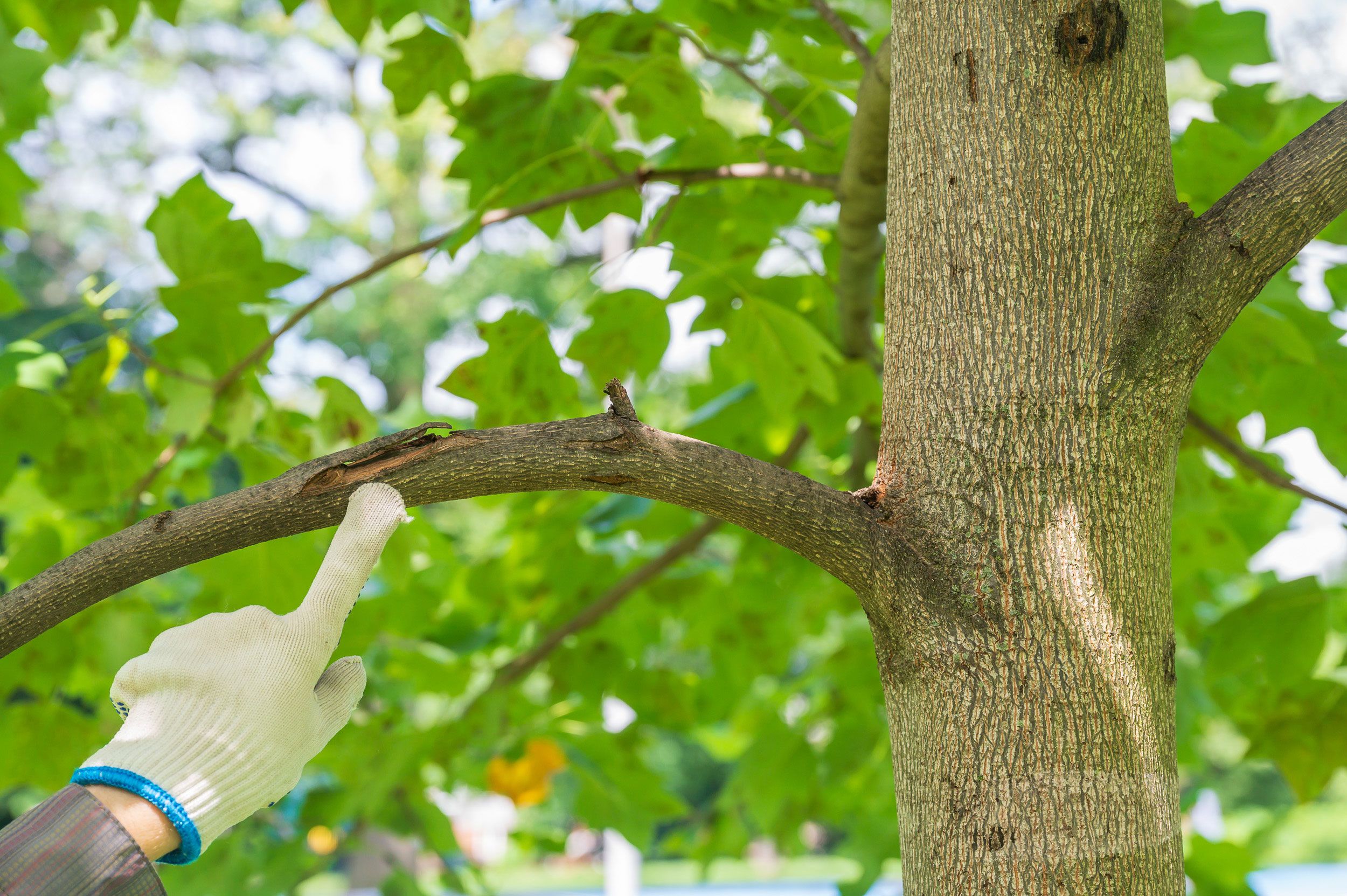
1. BEGIN WITH AN EVALUATION
Determine which branches need to be cut off right away. Remove no more than one-quarter of the tree’s living branches in a year. (That applies only to young, healthy trees.) Look around to be sure that any branches you cut will fall out of harm’s way.

2. LOCATE THE BRANCH COLLAR
This is often a visible swelling at the base of the branch where it’s attached to the trunk or a parent branch. Avoid cutting into the branch collar, Dentice says, because it contains chemicals that provide a natural barrier against decay and will speed formation of a callus over the wound.

3. KEEP YOUR CUTS SMALL AND CIRCULAR
Under 2 inches if possible. Wounds are not healthy for a tree. The larger the cut, the more time and energy it will take the tree to seal it, making the tree more susceptible to stress, disease and decay. Use the bypass hand pruners to remove problematic little branches less than one half-inch in diameter. Cut on a diagonal at a spot less than one-quarter of an inch above an outward-facing bud or branch. Set the cutting blade next to the stem to make the closest, cleanest cut.

4. TWIST THE SUCKERS
The tiny sprouts that show up around the base of the trunk can hinder the tree’s healthy growth. The best time to remove them is when they’re small. Using your hands, firmly twist and pull the suckers off at the point of origin to avoid regrowth.

5. USE THE THREE-CUT METHOD
With a larger, heavier branch, the weight of the limb can cause it to tear away from the trunk and rip the bark as you get close to cutting through it. This can leave a tree susceptible to pests and diseases. The three-cut method prevents it. The process is simple: Using a pruning saw, make a first cut on the underside of the branch several inches from the trunk. Saw upwards one-third of the way through the branch. Start a second cut on the topside of the limb and saw through to the first cut so that the bulk of the branch breaks away at that spot. For the third cut, locate the branch collar. Carefully saw off the stub of the branch just outside the collar.

6. CLEAN UP
You can leave trimmings behind as mulch for the tree, or you can gather them up and move them to a compost pile. When you’re done pruning, clean your tools with rubbing alcohol to disinfect them and prevent the transfer of diseases to other trees.
Learn more about the PHS tree programs, classes, and how you can get involved.

Early Risers
HELLEBORES START THE BLOOMING SEASON WHEN THEIR COLORFUL FLOWERS EMERGE IN LATE WINTER TO EARLY SPRING.
by SCOTT MEYER
photographs by ROB CARDILLO
ABOUT HELLEBORES
FAMILY Ranunculaceae
GENUS Helleborus
USES Groundcover, mass planting, mixed border, rock garden, woodland garden, edging, and slopes.
GROWING CONDITIONS Partial to full shade; humus-rich, well-drained soil.
CAUTION Hellebores are poisonous for people and pets. Some gardeners report developing a rash after coming in contact with the sap, so it’s best to wear gloves when handling them.

The variety of hues in hellebore flowers blend and contrast beautifully in a simple arrangement.
The variety of hues in hellebore flowers blend and contrast beautifully in a simple arrangement.
HELLEBORES WOULD GRAB YOUR ATTENTION ANY TIME OF YEAR. They have large, open-faced blossoms in hues of pink, purple, yellow, white, and green (depending on the variety), and they bring color to shady areas of your landscape. The flowers can last for weeks or even months, and these low-growing perennial plants come back reliably for decades. Once established, hellebores require almost no care. Sometimes referred to as “Lenten roses” or “Christmas roses,” hellebores are most valued because their show begins before anything else is in bloom. “I might be the victim of helleborus seduction,” says David Culp, author of A Year at Brandywine Cottage (Timber Press, 2020) and breeder of a series of hellebores known as the Brandywine hybrids. “I’ve heard it said that no garden should rest on one genus, but I built my garden at the cottage around hellebores.”
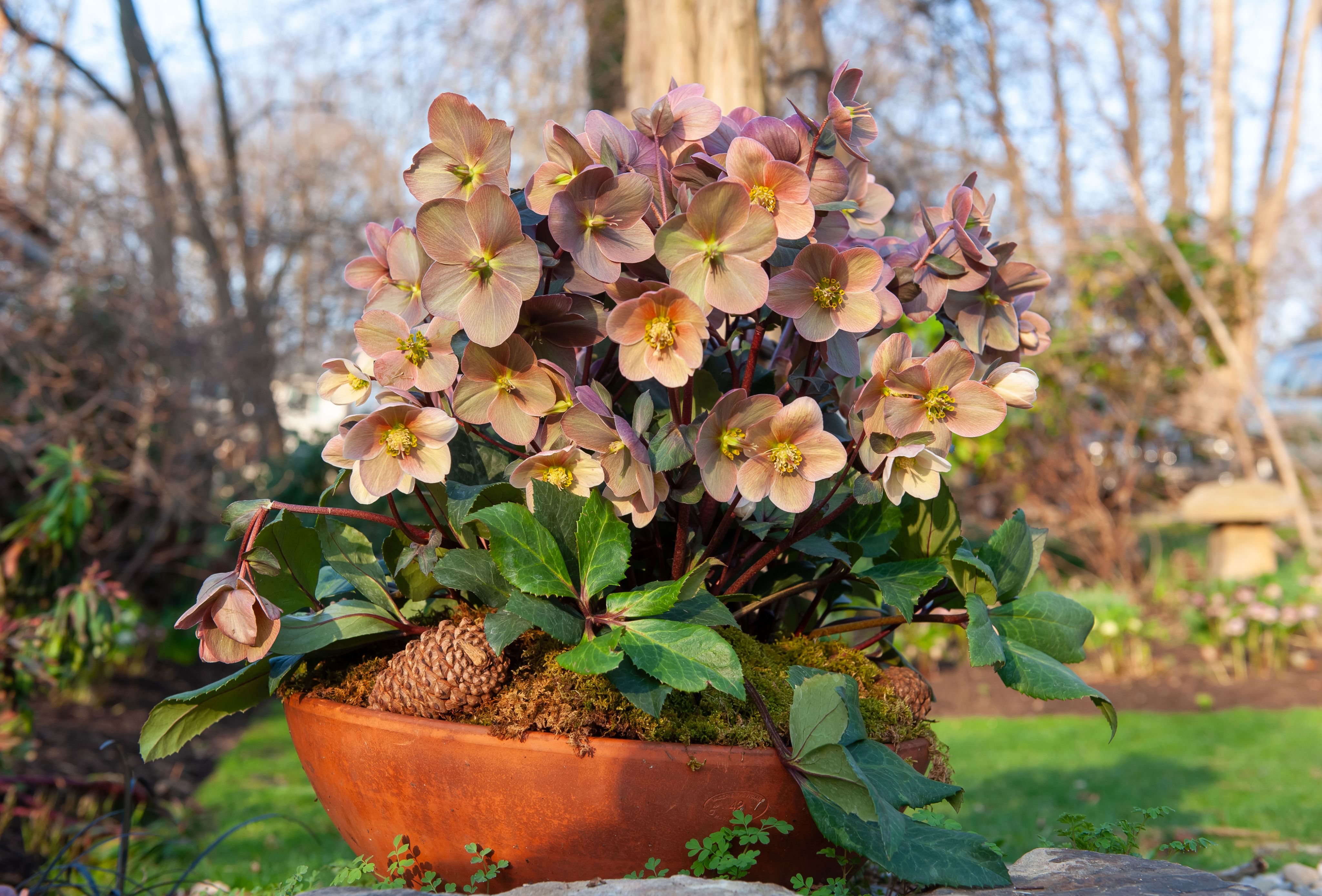
H. nigercors is the best choice for growing in containers.
H. nigercors is the best choice for growing in containers.
HYBRID VIGOR
The Helleborus genus includes approximately 20 species and additional subspecies, but the most commonly available hellebores are hybrids of H. orientalis and other Helleborus species. Sometimes known as oriental hellebores (and listed by their more accurate botanical name H. × hybridus), they bloom around the time that the Christian celebration of Lent begins. They are “vigorous and very easy to get established,” Culp says. These hybrids tolerate almost full sun to almost full shade but bloom best in partly shaded areas. The flowers can be drooping or nearly upright, deeply cupped or almost flat, with single, semidouble (anemone), or full double petals.
Culp, who has served as a judge at many PHS Philadelphia Flower Shows, has bred his own selections of Helleborus Brandywine from plants that he has collected from England, Germany, and his own garden. “I focus my breeding work chiefly on color forms and vigor,” he says. These hybrids bloom in hues such as dark red, spotted pink, apricot, and picotees (edged in different colors). The plants grow 12 to 15 inches tall and have leathery, dark-green leaves. (You can order Brandywine hybrids from Izel Native Plants [izelplants.com] and they are found in many local nurseries.)
For containers, consider Helleborus × nigercors. “You can plant any hellebore in a pot, though most of them fit best in a natural setting,” Culp says. “But nigercors has a stylized look that makes it outstanding in a container.” Its foot-high stalks bear large flat flowers that open in a creamy color and then gradually turn green.

A selection of Brandywine hellebores float in a shallow bowl, an ideal way to display them.
A selection of Brandywine hellebores float in a shallow bowl, an ideal way to display them.
IN YOUR GARDEN
Despite their delicate appearance, hellebores need little care and attention. Just plant them in dry to lightly moist soil, ideally in partial shade, and they will thrive. Hellebores survive summer droughts, but the one condition that they cannot tolerate is soggy soil. They will rot before they bloom if their roots stay wet.
“I add a light layer of leaf mold around the plants each fall, and that’s about it,” Culp says. He also cuts off the previous season’s foliage before winter settles in. “I remove the foliage before the next blooms start to form because it helps the new flowers to stand out more,” he explains. “It really makes a huge difference in how they look.”
Hellebores have no identified pest or disease problems. The plants also seem to be unappealing to deer and rabbits, perhaps because they contain a type of sap that is known to be toxic to people and pets. “I am building a palette of deerproof plants,” Culp says, “and hellebores fit right in.”
Hellebores are suited to a wide range of places in a landscape, including rock gardens, pathway edging, and woodland areas. They work well as a groundcover beneath deciduous trees and shrubs. Dark-red and nearly black varieties create a dramatic look, but they “can recede from your vision,” Culp says. He recommends pairing them with white, bright-yellow, and green varieties to help the darker blooms be noticed. Plant hellebores with other early bloomers, such as daffodils, primroses, and galanthus (another of Culp’s favorite species) for a continuous display through the spring.

Plant hellebores where you can see their brilliant colors in winter.
Plant hellebores where you can see their brilliant colors in winter.
After the flowers are finished, move pots into the shade for the summer. The foliage looks fresh for months after the blooms fade and even endures through heavy snowfall. “You should plant hellebores where you will see them in winter,” Culp advises. They do well in pots and in window boxes, so you can place them in spots viewable from inside in cold weather.
Propagating hellebores to increase their population in your garden is easy. All you need to do is dig up the plants after they bloom and gently break them into several pieces with roots attached. Or just let nature take its course, and the plants will drop their seeds. It can take a year or more for the seeds to germinate and a few seasons for the plants to bloom, but then you’ll have a clump of colorful hellebores to brighten the gray days of winter for years to come.


100 N 20th Street | Philadelphia, PA 19103
215.988.8800
